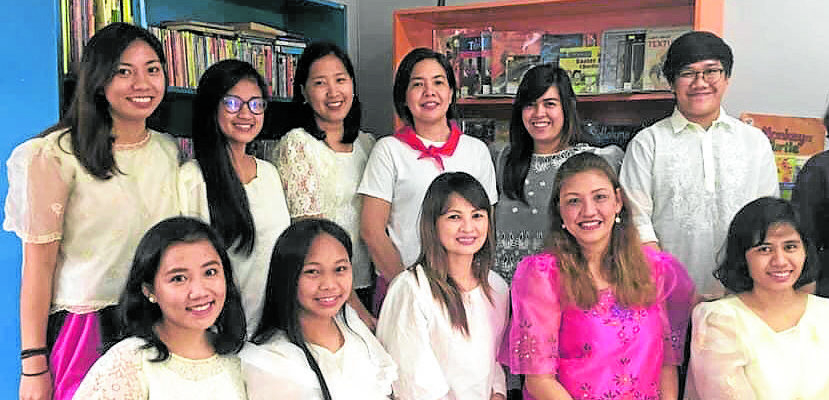
Vanny Bicomong immediately thought it was an unusual request.
It was 2008, three years after the longtime marketing professional had started The Learning Library as a “community-based learning center project.”
Starting in Loyola Heights with just one teacher focusing on English, the tutorial center now has 22 employees and tackles all subjects. One particular subject caught her attention.
“Our Reading students said that they needed more help in Filipino comprehension, not English,” Bicomong said. “We realized that they could not understand because they had very little exposure to Filipino on a daily basis. No one was talking to them regularly in Filipino, and all they watched and listened to was in English. This was over 10 years ago! There are so many more kids today who have English as their native language.”
‘Well-rounded program’
This is how The Learning Library spawned the online Filipino tutorial program Wika’y Galing!
“It’s a well-rounded program for teaching Filipino as a second language. We develop the critical skills—comprehension, speaking and writing—level by level. Students enjoy daily activities for language exposure, including access to our online library of storybooks from Adarna House. They meet with our teachers and classmates on a regular basis. All this is done online—perfect for the quarantine period.”
There is a burgeoning audience for learning Filipino through online platforms. Even though it is the official national language and is a school subject, more and more Filipinos are falling behind in their Filipino fluency. The online tutorials serve as addition to the arsenal of learning tools for this gap.
“Many young Filipinos find difficulty in communicating in Filipino, and it’s a real problem,” said Asa Montenejo, president of Adarna House, which also developed The Learning Library’s Wika’y Galing! online portal, and provided digital learning materials and integration to Adarna’s on-demand e-book platform BuriBooks (buribooks.com).
“Problem ito from the home dahil hindi ginagamit ang Filipino sa pang-araw-araw na pakikipag-usap. There is also a lack of literature in Filipino for the intermediate grades so they almost exclusively read in English, at siyempre problem din ito sa school, hindi na-e-encourage ang mga bata na paghusayan ang Filipino.”
There were many reasons for this, among them that the students would get laughed at when they spoke Filipino, but with Filipino being part of the curriculum, the lack of Filipino fluency has a negative effect academically, Bicomong noted. “Low Filipino grades prevented them from getting academic honors, and school requirements just got harder year after year.”
Consequences
There are other dire consequences, as well. “You can’t even pass the Upcat (University of the Philippines College Aptitude Test) because 50 percent of the comprehension questions are in Filipino,” she said. “I personally feel sad because many young people will not be able to appreciate Filipino music, movies and literature. They cannot access the beauty of their own culture.”
Wika’y Galing! students are usually age eight to 18. “We invite them for a free online assessment to determine their needs, and find out what level they are,” she said. “They get classmates who are in the same level and come to the scheduled online classes.”
The monthly fee of P2,800 gives students unlimited access to the portal and e-books.
While the program usually has students from what Bicomong described as “traditional schools with a strict Filipino curriculum,” the quarantine period has seen an influx of students from all kinds of schools, a trend that Montenejo said would continue. “I believe we will start to see more of these now because of the COVID-19 (new coronavirus disease) situation—there will be an increased demand for online learning content,” she said.
There is the need for the creation of even more media and material in Filipino, and anchoring these on experiences and circumstances that young Filipinos can identify with. Bicomong said not only do they connect the lessons to Filipino culture to make them relevant, but the goal has always been to make learning Filipino a positive experience to give the students the confidence to become fluent.
Even as the market—and the necessity—for teaching Filipino as a second language through online platforms grows, parents can do much to help their kids. “Parents can help by using Filipino in conversing with their children. It sounds very simple but it’s very effective in making them learn and use the language,” Montenejo said.
Daily usage
Bicomong said the exposure needs to be done daily, thoroughly and in diverse ways. It needs to be in the air constantly, not just on the screens or the printed page. “Make every day Filipino learning day,” she said. “Studies show that you need to be exposed to a language at least 30 percent of your waking hours to achieve fluency—make sure your child reads, watches, or speaks Filipino at least an hour a day.
“Be a living dictionary, because using a real Filipino dictionary can be tedious. Ask a question in Filipino, and if they can’t reply, give them the answer and have them repeat it to you. Start a notebook where they list all the Filipino words they learned that day. Above all, be good role models in appreciating the language, and be patient with them as they learn. Make them interested because you are interested to teach them. Sa gusto, may paraan.” INQ
Tel. 0917-8282669; email inquiry@wikaygaling.com; visit wikaygaling.com.